 Building anything takes time and involves effort, resources, and yes, maybe even some blood, sweat, and tears. Producing high performance teams is no different. That’s why we call it Building High Performance Teams. Many professionals may think that building high performance teams begins with the hiring process; and yes, that is part of the process. However, laying the foundation begins long before that with your strategic planning process with the cornerstone being your vision, mission, and business philosophy.
Building anything takes time and involves effort, resources, and yes, maybe even some blood, sweat, and tears. Producing high performance teams is no different. That’s why we call it Building High Performance Teams. Many professionals may think that building high performance teams begins with the hiring process; and yes, that is part of the process. However, laying the foundation begins long before that with your strategic planning process with the cornerstone being your vision, mission, and business philosophy.
Once those components are in place, then you can begin writing position descriptions for the tasks to help the job talk as to what it needs to function at an optimal level. Seeking the talent for those positions involves looking for a match in KSAs (knowledge, skills, and attributes). Remember that when you find the person with the right attitude and is a match for your vision, mission, and business philosophy, you can always train for skills. But that’s just the beginning.
 There are no guarantees in business. On the other hand, no CEO should take wild chances or gamble with success, especially when an easy trifecta for success is attainable. Once you’ve reached the ivory tower where CEOs lives, life is smooth sailing right? Not exactly. When you were working hard to reach this plateau, you probably only had one boss. Now you may have six or 12 depending on the size of your Board. You probably had people to manage. Now, however, you inherit an executive team to help you bear the burdens of leadership that has more power and input than people you were managing. Now the stakes are higher and getting them all on the same page, may prove to be a challenge. You can bet that one or two of them wanted the CEO position and may prove to be difficult. Maybe at least one thinks you’re not the right person for the job. Others may just want to hang onto their hands or jobs, and hope you don’t come in wielding an ax. Whether you’re a new or seasoned CEO, an article in HBR provides information for the Ace up your sleeve.
There are no guarantees in business. On the other hand, no CEO should take wild chances or gamble with success, especially when an easy trifecta for success is attainable. Once you’ve reached the ivory tower where CEOs lives, life is smooth sailing right? Not exactly. When you were working hard to reach this plateau, you probably only had one boss. Now you may have six or 12 depending on the size of your Board. You probably had people to manage. Now, however, you inherit an executive team to help you bear the burdens of leadership that has more power and input than people you were managing. Now the stakes are higher and getting them all on the same page, may prove to be a challenge. You can bet that one or two of them wanted the CEO position and may prove to be difficult. Maybe at least one thinks you’re not the right person for the job. Others may just want to hang onto their hands or jobs, and hope you don’t come in wielding an ax. Whether you’re a new or seasoned CEO, an article in HBR provides information for the Ace up your sleeve.
 Most articles on blind spots are written about leaders and their blind spots. OK, in the interest of transparency, even I’ve written a couple in that same vein The RX for Diagnosing and Curing Blind Spots and Seeing Your Blind Spots
Most articles on blind spots are written about leaders and their blind spots. OK, in the interest of transparency, even I’ve written a couple in that same vein The RX for Diagnosing and Curing Blind Spots and Seeing Your Blind Spots
People at all levels in all organizations have a blind spot about something. Since leaders in the C-Suite bear a lot of responsibility, blind spots can be expensive and therefore garner the most attention. However, regular people, like you and me with the non-leadership salaries, need to be just as aware of our own blind spots that you may think don’t matter. And why is that?
 One of the biggest contributors to poor employee engagement is the lack of a structured employee development program. Several sources suggest that about half of organizations have no employee development program. Some that do have such a program, describe it as broken, or outdated.
One of the biggest contributors to poor employee engagement is the lack of a structured employee development program. Several sources suggest that about half of organizations have no employee development program. Some that do have such a program, describe it as broken, or outdated.
Just as with anything, creating an employee development plan involves strategy and prework. This prework begins long before anyone makes a hire, advertises an opening, writes a job description, or even before someone decides what positions the organization will fill. What ideas can an organization implement to ensure that an employee development program is successful?
 People often think that mixing analytics and talent management is like mixing oil and water. To some managers talent management is equal to getting a bunch of third graders to stand in a straight line, keep quiet, and do their assignments. Unfortunately, some may still have that mindset. Data analytics can help managers and organizations find, hire, and manage talent better than ever before.
People often think that mixing analytics and talent management is like mixing oil and water. To some managers talent management is equal to getting a bunch of third graders to stand in a straight line, keep quiet, and do their assignments. Unfortunately, some may still have that mindset. Data analytics can help managers and organizations find, hire, and manage talent better than ever before.
 According to the CEO Economic Outlook Survey Q2 2015, CEOs will begin cutting back on spending and start working on layoffs. Here we go again. The people who need the money will no longer be making any, families will suffer, and the economy will be taking another nose dive. An important question to ask is what will these layoffs, lack of people power, and lost revenues do to your organization? What if there were a more creative way CEOs could keep their employees working, save families, save their communities, save the economy, and boost their organization all at the same time?
According to the CEO Economic Outlook Survey Q2 2015, CEOs will begin cutting back on spending and start working on layoffs. Here we go again. The people who need the money will no longer be making any, families will suffer, and the economy will be taking another nose dive. An important question to ask is what will these layoffs, lack of people power, and lost revenues do to your organization? What if there were a more creative way CEOs could keep their employees working, save families, save their communities, save the economy, and boost their organization all at the same time?
When conducting Tandem Team X-Ray Programs, it becomes clear that teams can be created that would allow employees to use their skills and attributes for real purpose. This helps satisfy the need employees have of wanting purpose in the workplaces. When employees work with purpose, they are more engaged and more productive. Leaders today have many opportunities to create meaning and purpose.
Results of assessments can identify employees with the following skills and attributes. In addition, ideas are presented on ways to help employees put these skills and attributes to good use, help the economy, and provide CEOs with a way to boost the organization.
 The inconsistent performer on your team is one of the most difficult management challenges managers, especially new managers, face. It’s like flipping a coin, you never know if a good day or bad day will be the performance de jour for this employee. This blog looks at how to recognize performance signs, causes of poor performance, and some solutions.
The inconsistent performer on your team is one of the most difficult management challenges managers, especially new managers, face. It’s like flipping a coin, you never know if a good day or bad day will be the performance de jour for this employee. This blog looks at how to recognize performance signs, causes of poor performance, and some solutions.
How to Recognize Inconsistent Performance: The most obvious way is to recognize performance patterns. Everyone at every level in any organization has a bad day occasionally. You can use your top performers as benchmarks to understand performance patterns. For example, observe the number of days of good performance and how consistently these top performers produce quality projects. At the other end of the spectrum, here are some items to observe in an inconsistent performer:
DID YOU KNOW THAT THE FAILURE RATE FOR NEW MANAGERS IS *46%!?
Why was the First Time Managers Coaching Program Created?
As a former manager in human resources, witnessing the promotion of unqualified people to management was heartbreaking. And the failure rate was proving costly. As an executive coach, I can see these failures manifest when there is a lack of solid leadership training.
New managers rarely have the training they need, and certainly don’t have any of the experience an executive possesses. Indeed, most new managers are promoted primarily because they are doing a good job in their current position. That doesn’t necessarily make them management material.
The executive staff are the people who get the resources such as training, off-site retreats, and coaching. Of course, it is a good idea to put resources behind the executive staff because, after all, they are carrying a lot of risks for the success of the organization.
But think about this. New managers are the people who could one day fill the shoes of an executive in your organization. I dare say that any executive you speak with wishes he or she had more “care and feeding” about how to manage and lead as they started up and continued to climb the ladder into the executive suite.
That’s why I’ve created a coaching program specifically designed for managers with zero to three years’ experience. This program is affordable, so the organization can not only justify, but recoup the investment, and reap benefits the company will profit from for years to come.
Schedule an Appointment
How does the First Time Managers Program Work?
The new manager takes the TriMetrix HD Assessment, and receives a report consisting of:
- Behaviors:
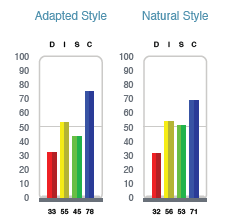
Behavioral research suggests that the most effective people are those who understand themselves, both their strengths and weaknesses, so they can develop strategies to meet the demands of their environment. This report measures the four dimensions of normal behavior: dominance, influence, steadiness, and compliance.
TriMetrix HD tells how the new manager will perform.
*Source: HR.com
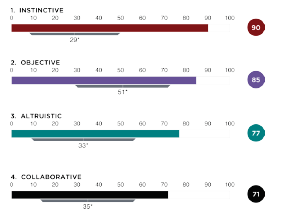 Knowledge of an individual’s driving forces helps tell us why a person behaves a certain way. 12 Driving Forces ™ measures an individual’s top four of driving forces to tell a story of how a person derives meaning from life and work.
Knowledge of an individual’s driving forces helps tell us why a person behaves a certain way. 12 Driving Forces ™ measures an individual’s top four of driving forces to tell a story of how a person derives meaning from life and work.
TriMetrix HD illuminates what drives this individual’s behavior – the why behind their actions.
- Competencies:
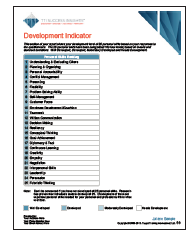
An individual’s hierarchy of competencies, including his/her leadership score, is key to their success. Knowing what they are is essential to reaching one’s goals. This report is designed to assist managing and developing a career. For many jobs, personal skills are as important as technical skills in producing superior performance.
TriMetrix HD describes what this individual “has done” in 25 research-based competencies related to the business environment.
Acumen Capacity Index:
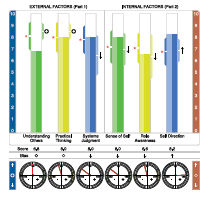
The Acumen Indicators section is designed to help individuals truly understand themselves and how they analyze and interpret their experiences. A person’s acumen, keenness, and depth of perception or discernment is directly related to performance.
TriMetrix ACI explores both how a person’s judgment impacts interaction with the external world, and his or her own self-perception.
In addition, the assessment reports contain self-coaching strategies that will guide the new manager beyond the coaching initiatives of this program.
Schedule an Appointment
Program Structure
Online assessment administration
3 months or 12 hours of coaching (Bonus: 1 extra hour at no charge in the first session!)
Unlimited access to the coach via phone and email during the coaching program
The Program is Designed To:- Increase clarity, focus, and direction
- Create a specific strategy and a plan to reach goals
- Build or enhance necessary skills
- Create a supportive environment to achieve success
- Deal with barriers that block goal achievement
Coaching Topics Include, but Are Not Limited To:
- Leadership myths and magic
- Understanding roles and responsibilities
- Critical/strategic thinking
- Handling relationships (former peers and supervisor)
- Understanding your team’s history
- Understanding performance management
- Communication
- Problem analysis and decision making (including making hard decisions)
- Creating a culture of accountability
- Motivating your team
- Coaching
- Evaluating your team
- Continuous learning and trends
Why am I Qualified to Coach?
- Ten years of coaching executives from a variety of industries across the United States and from Israel, Chile, South America, Japan, Germany, China, and Sweden.
- Certifications include: Registered Corporate Coach (RCC), Leaders Coaching Leaders Coach (LCL) and Facilitator, Certified Professional Driving Forces Analyst (CPDFA); (CPBA); (DISC Certified); Certified TriMetrix HD Analyst (CPHDA), and Certified Professional Emotional Quotient Analyst (CPEQA)
- Formal education includes a Masters of Arts in Industrial Organizational Psychology and a Bachelor of Science in Psychology
- Six years as a Human Resource Manager
Bonus I:
One complimentary extra hour of coaching in the first session, for a total of 14 hours of coaching.
Bonus II:
Diane’s eBook, How to Give Dull, Boring Meetings a Swift Kick in the Agenda. This book provides the new manager with insights on:
- How to manage different behavioral styles in meetings
- How to determine if a meeting is necessary
- Types of meetings
- How to have more effective meetings
- Ways to make meetings fun!
Bonus III:
A complimentary “check-in” call 3 months after our final session to help ensure the new manager is still on track. This brings the total number of coaching hours to 15!!
Let's get started to give your managers the leadership foundation they need to make it all the way to the Executive Suite!
 When immigrants come to America, they often see opportunities, and many become extraordinarily successful entrepreneurs. Many Americans who grow up with these same opportunities fail to see them and therefore neglect taking advantage of them. One thing we do have in common is resistance to change. While an immigrant might find success, the idea of being on time, for example, is a difficult idea to change for some cultures. The changes dictated by the pandemic have given us all change challenges to wrestle. How will these changes, many of which are here to stay, affect our work culture and what changes do we need to embrace for success?
When immigrants come to America, they often see opportunities, and many become extraordinarily successful entrepreneurs. Many Americans who grow up with these same opportunities fail to see them and therefore neglect taking advantage of them. One thing we do have in common is resistance to change. While an immigrant might find success, the idea of being on time, for example, is a difficult idea to change for some cultures. The changes dictated by the pandemic have given us all change challenges to wrestle. How will these changes, many of which are here to stay, affect our work culture and what changes do we need to embrace for success?

As a leader, when it comes to talent management, you often hear the call to not only have the right people on the bus, but also to have those people in the right seats. But what does that mean exactly? Yes, it means hiring the right people for the right position, but it also includes assignments the individual participates in once on board. Let’s look at some scenarios.
1. A frustrated VP and I were discussing a hiring project he was working on and that it had been assigned to one of his executives. When he told me this assignment was made six months ago and that no progress had been made, I began asking probing coaching questions designed to get at the core of the frustration.
It seems the assignment had been given to someone who is responsible for building business. Further, this individual is on salary plus commission. Where’s the motivation? This executive is not motivated to take money out of his pocket for a hiring project. Solution: Make the executive the chief advisor on the project and gather a few other individuals together who are not on commission or in sales and have them take on the hiring project.
 CEOs focus on strategy and must also ensure their organization is financially sound. There is another critical concern and that is talent. The savvy CEO is the one who understands the importance of hiring good talent, ensuring a good fit, and then continuously developing that talent. Good talent pulls organizations through the good times, tough times, major changes, and navigating a crisis. But the CEO cannot and should not take on the talent task alone. One of the major partners in the talent effort is HR. However, the CFO should also be a part of that talent task triangle. Having these two partners in place is a great benefit to the CEO.
CEOs focus on strategy and must also ensure their organization is financially sound. There is another critical concern and that is talent. The savvy CEO is the one who understands the importance of hiring good talent, ensuring a good fit, and then continuously developing that talent. Good talent pulls organizations through the good times, tough times, major changes, and navigating a crisis. But the CEO cannot and should not take on the talent task alone. One of the major partners in the talent effort is HR. However, the CFO should also be a part of that talent task triangle. Having these two partners in place is a great benefit to the CEO.
 Losing weight and managing have a lot in common. Both losing weight and managing people are difficult. If you’re overweight, you may often receive negative feedback about how your weight is affecting your health from family, friends, and your doctor. One of the most difficult tasks in managing people is giving negative feedback or terminating them. It just so happens that employees with bad attitudes, low performers, and the good days/bad days employees are weighing you and your department down just as excess body weight slows your body down.
Losing weight and managing have a lot in common. Both losing weight and managing people are difficult. If you’re overweight, you may often receive negative feedback about how your weight is affecting your health from family, friends, and your doctor. One of the most difficult tasks in managing people is giving negative feedback or terminating them. It just so happens that employees with bad attitudes, low performers, and the good days/bad days employees are weighing you and your department down just as excess body weight slows your body down.
Of course, the idea is to always try and keep employees by finding a way for them to add value. The employee might be able to contribute by performing different tasks on your team. They may be a better fit for another team in the same area, or they might be able to move to a different area of expertise, or location. On the other hand, allowing a poor performer, or a person with a bad attitude, or an employee who engages in unethical behavior to remain on your team is like carrying around 600 pounds of excessive baggage. However, if you feel the employee is salvageable, to ensure both yourself and the employee that you have made every effort to give them a fair chance, a good idea is to create a performance improvement plan (PIP).
 An executive tells me he would be conducting performance reviews this week, including an employee we’ll call Betty. I asked how Betty’s performance affected him. He replies, it doesn’t. I probe further, and as it turns out, Betty is a direct managerial report of his who, in turn, manages about 12 employees including a couple of assistant managers.
An executive tells me he would be conducting performance reviews this week, including an employee we’ll call Betty. I asked how Betty’s performance affected him. He replies, it doesn’t. I probe further, and as it turns out, Betty is a direct managerial report of his who, in turn, manages about 12 employees including a couple of assistant managers.
He continues this dialogue by stating that if it was up to him, he’d clean house and fire everyone because, Betty had given most of her reports a score of two but that Betty is doing a good job. I expect my head to stop spinning sometime next week. I think it’s safe to assume that this executive has no performance management program (PM) in place. What if he did? What would a PM do for him, his reports, and the organization?
Implementing a PM system can provide many benefits. An article by Aileen MacMillan serves to illustrate ow a PM benefits the organization, managers, and supervisors, and employees. For example, the article suggests such elements as accountability, performance, and productivity enjoy higher levels. Clearly, my executive friend could use these and more. So, what does a good PM system look like?
 Many of you will recognize these lyrics from the 1969 tune No Time by The Guess Who. Not having time for coaching is a message that continues to drone on by both managers who should be conducting it and individuals who should be engaging in it. However, we seem to be able to make time for low productivity, employee disengagement, failure to set goals, a lack of innovation…well I could drone on and on too.
Many of you will recognize these lyrics from the 1969 tune No Time by The Guess Who. Not having time for coaching is a message that continues to drone on by both managers who should be conducting it and individuals who should be engaging in it. However, we seem to be able to make time for low productivity, employee disengagement, failure to set goals, a lack of innovation…well I could drone on and on too.
The idea of having no time for coaching lingers despite the plethora of books, articles, scientific and case studies available touting the effectiveness of coaching. Nothing is a miracle cure all, but there are two ingredients necessary to facilitate the success of a coaching program, a good coach and the willingness of the person engaging in coaching to be coachable.
 The Great Resignation is becoming the bane of workplace existence. This is true not only for employers, but for employees as well. If you digest any reading, or listening material on the workplace, you will no doubt have an eye or ear full of information about The Great Resignation (TGR) and the wild numbers about how many people are leaving jobs, employers being unable to fill jobs, and the wild offers organizations are making to get people to come to work. Are the numbers really that high? Can we blame all this on Covid? Whether it can or cannot, what can we do?
The Great Resignation is becoming the bane of workplace existence. This is true not only for employers, but for employees as well. If you digest any reading, or listening material on the workplace, you will no doubt have an eye or ear full of information about The Great Resignation (TGR) and the wild numbers about how many people are leaving jobs, employers being unable to fill jobs, and the wild offers organizations are making to get people to come to work. Are the numbers really that high? Can we blame all this on Covid? Whether it can or cannot, what can we do?
 All too often managers rush the hiring process just to get a warm body in a seat to reduce the workload on current talent. Then the fun begins. All too often when rushing the hiring process, the new hire turns out to be a poor fit for the position, a mismatch for your culture, or they have a bad attitude. Oh, and since one time saving trick was neglecting checking backgrounds you find the individual has a gift for exaggeration in the interview and on their resume and does not have the skills required to do the job. Failing to take time to administer an assessment, you now discover that that this person is missing some important attributes and they come in late, leave early, need to take time off right away for some “personal” events that need their attention more than the job. Wait, what do you mean you do not think this is fun? No fun indeed. What is the cure for this hiring dilemma?
All too often managers rush the hiring process just to get a warm body in a seat to reduce the workload on current talent. Then the fun begins. All too often when rushing the hiring process, the new hire turns out to be a poor fit for the position, a mismatch for your culture, or they have a bad attitude. Oh, and since one time saving trick was neglecting checking backgrounds you find the individual has a gift for exaggeration in the interview and on their resume and does not have the skills required to do the job. Failing to take time to administer an assessment, you now discover that that this person is missing some important attributes and they come in late, leave early, need to take time off right away for some “personal” events that need their attention more than the job. Wait, what do you mean you do not think this is fun? No fun indeed. What is the cure for this hiring dilemma?
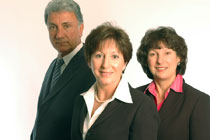
Older workers are a large and fast-growing part of the working population. Contrary to popular belief in America, and some other countries, at the age of 50 one’s brains do not fall out of your head, you do not automatically begin to drool, and you are still able to remember the way home after work. Unfortunately, some ageing Marthas and Melvins out there have given these workers a bad rap.
Some workers nearing retirement decide they will just coast their last two years or so at a company. The truth of the matter is probably that these folks were lousy employees all along and you didn’t have the nerve to fire them and now, as they near the grazing field of retirement, they have become sacred cows. Another case is that they feel useless and unappreciated and are just keeping a low profile. The scenario looks like this:
- They do the minimal amount of work to get by
- These scared cows are often popular with their co-workers
- Firing them could result in a grand mess of legal problems
- You may be years younger and fear challenging them
- They are not motivated by promotion or money
- They are not afraid of being fired
This may sound like a hopeless situation and you may feel that you are at the end of your rope when attempting to motivate your older charges who have fallen into this end of career abyss. Here are some ideas to consider to help get older workers involved and back in the game.

Most managers are unaware that a toxic employee is on their team. Toxic employees can be wily creatures. They are always nice to management and only act out when the boss is not around. They may even be super nice to someone’s face, but the minute their back is turned that person can be subjected to being derided, disrespected and having their character grilled and skewered.
It is even more difficult for a CEO to be aware of these toxic team members as they are so far removed from the front lines. Their blissful ignorance can even extend to their own executive teams.
Who are these misguided moppets? You can recognize them as they engage in the following behaviors: rudeness, bullying, bitterness, anger, being critical, having negative attitudes, and gossiping. We may think that all of us must put on our big boy or girl pants and deal with such issues from time to time. We need to reevaluate that idea.
The actions of a toxic employee are no small matter. According to an article by Christine Porath, Ph.D. for HBR, the poisonous trail they leave in their wake affects the entire organization and can foster an array of ills. This toxic waste includes:
 We all know that turnover is expensive. The Society for Human Resources Management suggests that the average cost per employee is around $4K. This figure considers direct costs such as advertising, recruiting fees, and interviewing time. Costs travel even higher when including more non-direct items such as lost productivity, low morale due to increasing workloads for employees who stay, and the impact on customer service. Now the cost soars anywhere between $10K to $200K depending on the position. Such costs can have a definite and negative impact on profits. There are ways to overturn these expenses through better hiring practices, but after the fact there are also numerous ways to be more proactive about reducing turnover.
We all know that turnover is expensive. The Society for Human Resources Management suggests that the average cost per employee is around $4K. This figure considers direct costs such as advertising, recruiting fees, and interviewing time. Costs travel even higher when including more non-direct items such as lost productivity, low morale due to increasing workloads for employees who stay, and the impact on customer service. Now the cost soars anywhere between $10K to $200K depending on the position. Such costs can have a definite and negative impact on profits. There are ways to overturn these expenses through better hiring practices, but after the fact there are also numerous ways to be more proactive about reducing turnover.
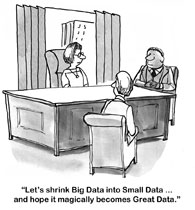 In the January/February issue of HR Magazine, Josh Bersin with Deloitte, makes nine predictions of “what’s in store for HR in 2015.” This is part seven of a series of nine articles looking at each of these predictions.
In the January/February issue of HR Magazine, Josh Bersin with Deloitte, makes nine predictions of “what’s in store for HR in 2015.” This is part seven of a series of nine articles looking at each of these predictions.
A sign on Albert Einstein’s door read: “Not everything that can be counted counts, and not everything that counts can be counted.” “Big data” is all the rage today, but does it really need to be all that big (think Neilson ratings) and is it really all that useful? Certainly data, statistics, and analytics are not new tunes that just hit the charts, particularly in the wonderful world of sports. Today we are using data, in both large and small businesses, to measure everything from behaviors such as a doctor’s bedside manner to data that could keep older drivers behind the wheel longer to data that reveals that employees who blog are happier Analytics involving more “clear cut” information such as economics, college admissions, and budgets will continue to prove useful. In addition, HR is now learning to use data for workforce planning. Moreover, data may help HR to obtain more of the business partner status it has been desiring for years.
It’s no secret that HR has not enjoyed a good reputation over the years and it has been waiting to be invited to “a seat at the table.” However, some wonder why HR has not “claimed” its seat at the table, by making itself more of a business partner. Unfortunately, many do not know where to begin to make such a transition happen. Analytics may be just the ticket. Let’s look at how analytics are changing the face of the workforce first.
 Building anything takes time and involves effort, resources, and yes, maybe even some blood, sweat, and tears. Producing high performance teams is no different. That’s why we call it Building High Performance Teams. Many professionals may think that building high performance teams begins with the hiring process; and yes, that is part of the process. However, laying the foundation begins long before that with your strategic planning process with the cornerstone being your vision, mission, and business philosophy.
Building anything takes time and involves effort, resources, and yes, maybe even some blood, sweat, and tears. Producing high performance teams is no different. That’s why we call it Building High Performance Teams. Many professionals may think that building high performance teams begins with the hiring process; and yes, that is part of the process. However, laying the foundation begins long before that with your strategic planning process with the cornerstone being your vision, mission, and business philosophy. There are no guarantees in business. On the other hand, no CEO should take wild chances or gamble with success, especially when an easy trifecta for success is attainable. Once you’ve reached the ivory tower where CEOs lives, life is smooth sailing right? Not exactly. When you were working hard to reach this plateau, you probably only had one boss. Now you may have six or 12 depending on the size of your Board. You probably had people to manage. Now, however, you inherit an executive team to help you bear the burdens of leadership that has more power and input than people you were managing. Now the stakes are higher and getting them all on the same page, may prove to be a challenge. You can bet that one or two of them wanted the CEO position and may prove to be difficult. Maybe at least one thinks you’re not the right person for the job. Others may just want to hang onto their hands or jobs, and hope you don’t come in wielding an ax. Whether you’re a new or seasoned CEO, an
There are no guarantees in business. On the other hand, no CEO should take wild chances or gamble with success, especially when an easy trifecta for success is attainable. Once you’ve reached the ivory tower where CEOs lives, life is smooth sailing right? Not exactly. When you were working hard to reach this plateau, you probably only had one boss. Now you may have six or 12 depending on the size of your Board. You probably had people to manage. Now, however, you inherit an executive team to help you bear the burdens of leadership that has more power and input than people you were managing. Now the stakes are higher and getting them all on the same page, may prove to be a challenge. You can bet that one or two of them wanted the CEO position and may prove to be difficult. Maybe at least one thinks you’re not the right person for the job. Others may just want to hang onto their hands or jobs, and hope you don’t come in wielding an ax. Whether you’re a new or seasoned CEO, an  Most articles on blind spots are written about leaders and their blind spots. OK, in the interest of transparency, even I’ve written a couple in that same vein
Most articles on blind spots are written about leaders and their blind spots. OK, in the interest of transparency, even I’ve written a couple in that same vein  One of the biggest contributors to poor employee engagement is the lack of a structured employee development program. Several sources suggest that about half of organizations have no employee development program. Some that do have such a program, describe it as broken, or outdated.
One of the biggest contributors to poor employee engagement is the lack of a structured employee development program. Several sources suggest that about half of organizations have no employee development program. Some that do have such a program, describe it as broken, or outdated. People often think that mixing analytics and talent management is like mixing oil and water. To some managers talent management is equal to getting a bunch of third graders to stand in a straight line, keep quiet, and do their assignments. Unfortunately, some may still have that mindset. Data analytics can help managers and organizations find, hire, and manage talent better than ever before.
People often think that mixing analytics and talent management is like mixing oil and water. To some managers talent management is equal to getting a bunch of third graders to stand in a straight line, keep quiet, and do their assignments. Unfortunately, some may still have that mindset. Data analytics can help managers and organizations find, hire, and manage talent better than ever before.  According to the CEO Economic Outlook Survey Q2 2015, CEOs will begin cutting back on spending and start working on layoffs. Here we go again. The people who need the money will no longer be making any, families will suffer, and the economy will be taking another nose dive. An important question to ask is what will these layoffs, lack of people power, and lost revenues do to your organization? What if there were a more creative way CEOs could keep their employees working, save families, save their communities, save the economy, and boost their organization all at the same time?
According to the CEO Economic Outlook Survey Q2 2015, CEOs will begin cutting back on spending and start working on layoffs. Here we go again. The people who need the money will no longer be making any, families will suffer, and the economy will be taking another nose dive. An important question to ask is what will these layoffs, lack of people power, and lost revenues do to your organization? What if there were a more creative way CEOs could keep their employees working, save families, save their communities, save the economy, and boost their organization all at the same time? The inconsistent performer on your team is one of the most difficult management challenges managers, especially new managers, face. It’s like flipping a coin, you never know if a good day or bad day will be the performance de jour for this employee. This blog looks at how to recognize performance signs, causes of poor performance, and some solutions.
The inconsistent performer on your team is one of the most difficult management challenges managers, especially new managers, face. It’s like flipping a coin, you never know if a good day or bad day will be the performance de jour for this employee. This blog looks at how to recognize performance signs, causes of poor performance, and some solutions.
 Knowledge of an individual’s driving forces helps tell us why a person behaves a certain way. 12 Driving Forces ™ measures an individual’s top four of driving forces to tell a story of how a person derives meaning from life and work.
Knowledge of an individual’s driving forces helps tell us why a person behaves a certain way. 12 Driving Forces ™ measures an individual’s top four of driving forces to tell a story of how a person derives meaning from life and work.

 When immigrants come to America, they often see opportunities, and many become extraordinarily successful entrepreneurs. Many Americans who grow up with these same opportunities fail to see them and therefore neglect taking advantage of them. One thing we do have in common is resistance to change. While an immigrant might find success, the idea of being on time, for example, is a difficult idea to change for some cultures. The changes dictated by the pandemic have given us all change challenges to wrestle. How will these changes, many of which are here to stay, affect our work culture and what changes do we need to embrace for success?
When immigrants come to America, they often see opportunities, and many become extraordinarily successful entrepreneurs. Many Americans who grow up with these same opportunities fail to see them and therefore neglect taking advantage of them. One thing we do have in common is resistance to change. While an immigrant might find success, the idea of being on time, for example, is a difficult idea to change for some cultures. The changes dictated by the pandemic have given us all change challenges to wrestle. How will these changes, many of which are here to stay, affect our work culture and what changes do we need to embrace for success?
 CEOs focus on strategy and must also ensure their organization is financially sound. There is another critical concern and that is talent. The savvy CEO is the one who understands the importance of hiring good talent, ensuring a good fit, and then continuously developing that talent. Good talent pulls organizations through the good times, tough times, major changes, and navigating a crisis. But the CEO cannot and should not take on the talent task alone. One of the major partners in the talent effort is HR. However, the CFO should also be a part of that talent task triangle. Having these two partners in place is a great benefit to the CEO.
CEOs focus on strategy and must also ensure their organization is financially sound. There is another critical concern and that is talent. The savvy CEO is the one who understands the importance of hiring good talent, ensuring a good fit, and then continuously developing that talent. Good talent pulls organizations through the good times, tough times, major changes, and navigating a crisis. But the CEO cannot and should not take on the talent task alone. One of the major partners in the talent effort is HR. However, the CFO should also be a part of that talent task triangle. Having these two partners in place is a great benefit to the CEO. Losing weight and managing have a lot in common. Both losing weight and managing people are difficult. If you’re overweight, you may often receive negative feedback about how your weight is affecting your health from family, friends, and your doctor. One of the most difficult tasks in managing people is giving negative feedback or terminating them. It just so happens that employees with bad attitudes, low performers, and the good days/bad days employees are weighing you and your department down just as excess body weight slows your body down.
Losing weight and managing have a lot in common. Both losing weight and managing people are difficult. If you’re overweight, you may often receive negative feedback about how your weight is affecting your health from family, friends, and your doctor. One of the most difficult tasks in managing people is giving negative feedback or terminating them. It just so happens that employees with bad attitudes, low performers, and the good days/bad days employees are weighing you and your department down just as excess body weight slows your body down.  An executive tells me he would be conducting performance reviews this week, including an employee we’ll call Betty. I asked how Betty’s performance affected him. He replies, it doesn’t. I probe further, and as it turns out, Betty is a direct managerial report of his who, in turn, manages about 12 employees including a couple of assistant managers.
An executive tells me he would be conducting performance reviews this week, including an employee we’ll call Betty. I asked how Betty’s performance affected him. He replies, it doesn’t. I probe further, and as it turns out, Betty is a direct managerial report of his who, in turn, manages about 12 employees including a couple of assistant managers. Many of you will recognize these lyrics from the 1969 tune No Time by The Guess Who. Not having time for coaching is a message that continues to drone on by both managers who should be conducting it and individuals who should be engaging in it. However, we seem to be able to make time for low productivity, employee disengagement, failure to set goals, a lack of innovation…well I could drone on and on too.
Many of you will recognize these lyrics from the 1969 tune No Time by The Guess Who. Not having time for coaching is a message that continues to drone on by both managers who should be conducting it and individuals who should be engaging in it. However, we seem to be able to make time for low productivity, employee disengagement, failure to set goals, a lack of innovation…well I could drone on and on too. The Great Resignation is becoming the bane of workplace existence. This is true not only for employers, but for employees as well. If you digest any reading, or listening material on the workplace, you will no doubt have an eye or ear full of information about The Great Resignation (TGR) and the wild numbers about how many people are leaving jobs, employers being unable to fill jobs, and the wild offers organizations are making to get people to come to work. Are the numbers really that high? Can we blame all this on Covid? Whether it can or cannot, what can we do?
The Great Resignation is becoming the bane of workplace existence. This is true not only for employers, but for employees as well. If you digest any reading, or listening material on the workplace, you will no doubt have an eye or ear full of information about The Great Resignation (TGR) and the wild numbers about how many people are leaving jobs, employers being unable to fill jobs, and the wild offers organizations are making to get people to come to work. Are the numbers really that high? Can we blame all this on Covid? Whether it can or cannot, what can we do? All too often managers rush the hiring process just to get a warm body in a seat to reduce the workload on current talent. Then the fun begins. All too often when rushing the hiring process, the new hire turns out to be a poor fit for the position, a mismatch for your culture, or they have a bad attitude. Oh, and since one time saving trick was neglecting checking backgrounds you find the individual has a gift for exaggeration in the interview and on their resume and does not have the skills required to do the job. Failing to take time to administer an assessment, you now discover that that this person is missing some important attributes and they come in late, leave early, need to take time off right away for some “personal” events that need their attention more than the job. Wait, what do you mean you do not think this is fun? No fun indeed. What is the cure for this hiring dilemma?
All too often managers rush the hiring process just to get a warm body in a seat to reduce the workload on current talent. Then the fun begins. All too often when rushing the hiring process, the new hire turns out to be a poor fit for the position, a mismatch for your culture, or they have a bad attitude. Oh, and since one time saving trick was neglecting checking backgrounds you find the individual has a gift for exaggeration in the interview and on their resume and does not have the skills required to do the job. Failing to take time to administer an assessment, you now discover that that this person is missing some important attributes and they come in late, leave early, need to take time off right away for some “personal” events that need their attention more than the job. Wait, what do you mean you do not think this is fun? No fun indeed. What is the cure for this hiring dilemma?

 We all know that turnover is expensive. The Society for Human Resources Management suggests that the average cost per employee is around $4K. This figure considers direct costs such as advertising, recruiting fees, and interviewing time. Costs travel even higher when including more non-direct items such as lost productivity, low morale due to increasing workloads for employees who stay, and the impact on customer service. Now the cost soars anywhere between $10K to $200K depending on the position. Such costs can have a definite and negative impact on profits. There are ways to overturn these expenses through better hiring practices, but after the fact there are also numerous ways to be more proactive about reducing turnover.
We all know that turnover is expensive. The Society for Human Resources Management suggests that the average cost per employee is around $4K. This figure considers direct costs such as advertising, recruiting fees, and interviewing time. Costs travel even higher when including more non-direct items such as lost productivity, low morale due to increasing workloads for employees who stay, and the impact on customer service. Now the cost soars anywhere between $10K to $200K depending on the position. Such costs can have a definite and negative impact on profits. There are ways to overturn these expenses through better hiring practices, but after the fact there are also numerous ways to be more proactive about reducing turnover. In the January/February issue of HR Magazine, Josh Bersin with Deloitte, makes nine predictions of “what’s in store for HR in 2015.” This is part seven of a series of nine articles looking at each of these predictions.
In the January/February issue of HR Magazine, Josh Bersin with Deloitte, makes nine predictions of “what’s in store for HR in 2015.” This is part seven of a series of nine articles looking at each of these predictions.